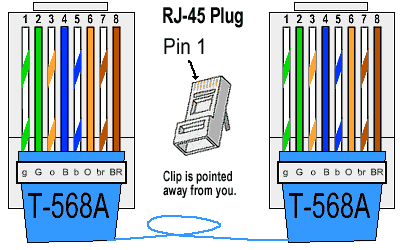Running Ethernet
Running Ethernet throughout your house.
Materials
As a bare minimum you'll need the following:
- Ethernet Cable.
- RJ45 Plugs. 100 pack
For more professional installs, you'll also want to have:
- Cat7 Ethernet Cable for 10 gigabit.
- Keystones Wall Plates Mounting Brackets
For outdoor runs, you'll need the following:
- Cable clips
- Or nails if you'd rather use a nail gun.
- Duct Seal for filling holes.
Ethernet Cable
These days, you should be using Cat6, Cat6a, or Cat7 cables.
Cat6 is suitable for Gigabit runs up to 100 meters and 10 Gigabit up to 55 meters.
For longer 10 Gigabit runs though, you'll want either Cat6a or Cat7. Both support 10 Gigabit up to 100 meters.
Cat7 will also do 40 Gb at 50 meters and 100 Gb at 15 meters.
Avoid Cat5 and 5e cables. These are fairly old standards and only marginally cheaper than Cat6.
Cat5 which came out in 1995 doesn't support Gigabit.
Cat5e came out in 2000 and supports Gigabit. It is fine for short patch cables but I wouldn't run them through the walls.
- Avoid CCA (Copper clad aluminum) cables;. They're less reliable and less resilient to bending.
- Shielded cables are unnecessary for most installs. You'll only need them if you plan to run them along power lines. They're also more difficult to work with.
- I've had luck with premiertek_official's 1000 ft Pure Copper Outdoor Cat6 on eBay.
Tools
For basic runs, you'll only need the following:
For outdoor runs, get the following:
- A drill for outdoor runs and relevant bits. You will need a long drill bit (12 in) to drill through walls. Normal bits are sufficient for drilling through studs.
- Notes
- There are some cheap kits on amazon which include multiple items (e.g. crimper, wire stripper, tester, plugs). I cannot comment on the quality of them.
- The basic cable tester only ensures continuity. You should do a quick iperf3 test to make sure you're getting the speeds you expect.
Terminating Ethernet Cables


Terminating an ethernet cable is fairly straight forward:
- Strip the end of the cable approx 1 inch.
- Cut off the rip-cord and plastic separator.
- Line up the stands and trim them to equal length.
- Stick them inside the Rj45 jack and crimp.
- Notes
- Hold the cable still as you trim the strands and crimp. Otherwise their length will change.
There are two standards for terminating ethernet cables: T568A and T568B.
T568B is the newer standard and the one I use.
It doesn't matter which standard you use as long as it is consistent on both ends of the cable.
